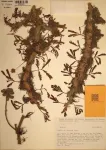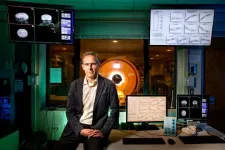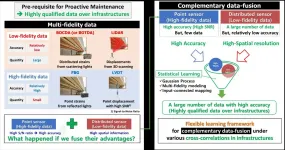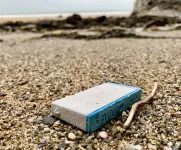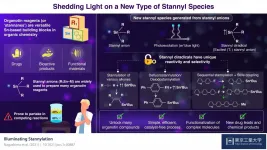(Press-News.org) Within the past decade, next-generation sequencing technologies have revolutionized the way in which genetic data are generated and analyzed. In the field of phylogenetics, this has meant that researchers are rapidly reconstructing the tree of life, a goal that biologists have been working toward since Darwin sketched the first phylogeny in his notebook in 1837.
Yet despite the relative ease with which DNA can now be sequenced in large quantities, scientists must first extract that DNA from an organism, often relying on vast numbers of curated specimens in museums and herbaria. With over 250,000 species in the plant kingdom alone, the acquisition and documentation of specimen material is now by far the most time-consuming and error-prone process in large studies.
In a research article published in a recent issue of Applications in Plant Sciences, researchers undertook the goal of automating the collecting process by using a combination of unique object identifiers, QR codes, and citizen science.
"Our goal was to create a resource for the scientific community," said lead author Ryan Folk, an assistant professor and herbarium curator at Mississippi State University. "In the future, we hope that all such collection information will be available online, where it's easy to find and the work won't need to be repeated."
Folk and his colleagues are working to create a partial -- 50 percent coverage -- phylogeny of seed plants that harbor nitrogen-fixing bacteria in specialized root nodules. This symbiotic relationship spans several disparate seed plant groups that collectively contain more than 30,000 species, for which the team relied entirely on herbarium specimens.
For a project of this scale, that meant members of the team worked for weeks at a time at multiple herbaria, focusing their efforts primarily at the New York and Missouri Botanical Gardens and the California Academy of Sciences.
Ordinarily, this would involve sifting through specimen material and manually transcribing or copying voucher information (such as the specimen locality, date, and name of the collector(s)) into a spreadsheet, as well as manually copying labels onto the samples themselves.
This process is absolutely essential for downstream analyses, but it requires large amounts of time and creates the potential for error. The biggest drawback, however, is the information garnered at this stage is typically only useful to the researchers who collected it and cannot be easily shared between groups. If a different group of researchers wanted to extract DNA from the same specimens, they would have to re-collect all of the same data.
Folk and his colleagues, wanting to curtail this duplication of effort, devised a digitization workflow whereby voucher information would only need to be collected once.
"Our workflow is made up of essentially several strategies -- more or less connected -- that takes you straight from walking into a museum all the way through data analysis and publication," said Folk.
At a glance, the process has three steps. First, a unique object identifier is assigned and physically attached to each herbarium voucher, and the specimen is photographed with the identifier clearly visible.
To transcribe the data from the roughly 15,000 specimens they used for the study, they used the citizen science platform Notes From Nature, which offers an online, interactive workspace where volunteers can join specific projects from home and communicate with researchers involved in the study.
By itself, this digitization of specimen information with unique object identifiers will be a valuable tool for researchers in the future and may ultimately complement the monumental effort being undertaken in museums around the world to digitize collections. But the researchers didn't stop there.
In the third step, QR codes were assigned to each specimen to further streamline data collection. This meant that when extracting and amplifying DNA in the lab, the researchers no longer had to manually enter specimen data into spreadsheets. Instead, that information was auto-populated when they scanned a given QR code.
"Scanning QR codes was basically effortless and didn't require any training or set up," said study co-author Heather Kates, a post-doctoral associate at the University of Florida. "But more important than the time-saving aspect of this approach was the reduction of errors. The errors introduced through illegibility and typos are a pain when you're doing a set of 20 extractions; you can imagine how important it is with 15,000 that those errors are avoided as much as possible."
Rather than keeping all of this information in spreadsheets, which have limited utility for specialized queries or data analysis, the team also created their own database using Python scripts.
The detailed workflow and Python scripts have been made freely available online so that researchers can access and fine-tune them for personalized use in their own studies.
"Although we have seen large DNA datasets published in recent years, reuse of data from many projects has been minimal due to the difficulty of accessing data online," said Folk. "In the long-term, we will release the data to the community in a form more easily amenable to future researchers. My hope is that our efforts will jump-start major projects focused on other organisms as well as establish a new baseline for biodiversity in the nitrogen-fixing clade of seed plants."
INFORMATION:
Citation: Folk, R. A., H. R. Kates, R. LaFrance, D. E. Soltis, P. S. Soltis, and R. P. Guralnick. 2021. High-throughput methods for efficiently building massive phylogenies from natural history collections. Applications in Plant Sciences 9(2): e11410. https://doi.org/10.1002/aps3.11410
Applications in Plant Sciences (APPS) is a monthly, peer-reviewed, open access journal focusing on new tools, technologies, and protocols in all areas of the plant sciences. It is published by the Botanical Society of America, a nonprofit membership society with a mission to promote botany, the field of basic science dealing with the study and inquiry into the form, function, development, diversity, reproduction, evolution, and uses of plants and their interactions within the biosphere. APPS is available as part of the Wiley Online Library.
For further information, please contact the APPS staff at apps@botany.org.
DALLAS, April 29, 2021 -- Health care professionals should consider prescribing medication for patients with slightly elevated blood pressure if levels do not decrease after six months of healthy lifestyle changes, according to a new scientific statement from the American Heart Association. The statement, published today in the Association's journal Hypertension, fills a gap in guideline recommendations by addressing how to manage untreated, stage 1 high blood pressure - levels of 130-139/80-89 mm Hg - that was not fully addressed in the 2017 treatment guidelines.
The 2017 American College of Cardiology/American Heart Association Blood Pressure Management ...
Eye contact plays a fundamental role in human communication and relationships. When we look into each other's eyes, we show that we are paying attention to each other. However, we do not only look at each other but also at our four-legged companions. According to new research by Hungarian ethologists, at least four independent traits affect dogs' ability to establish eye contact with humans. Short-headed, cooperative, young, and playful dogs are the most likely to look into the human eye.
Dogs adapted uniquely well to live with humans, and communication plays a vital ...
Less than one percent of people in the United States use kratom, a plant-based substance commonly used to manage pain and opioid withdrawal, according to a study published in the American Journal of Preventive Medicine. However, the use of kratom--which is legal but carries the risk of addiction and harmful side effects--is more prevalent among people who use other drugs, particularly those with opioid use disorder.
Derived from a tree native to Southeast Asia, kratom can be taken as a pill, capsule, or extract, or brewed as a tea. It acts on the brain's opioid receptors; at low doses, kratom is a stimulant, while at higher doses, it can relieve pain. Some people report using kratom as a substitute for opioids in an effort ...
CHAMPAIGN, Ill. -- Researchers have created a new, open-access tool that allows doctors and scientists to evaluate infant brain health by assessing the concentration of various chemical markers, called metabolites, in the brain. The tool compiled data from 140 infants to determine normal ranges for these metabolites.
Published in the journal NMR in Biomedicine, the study describes an easier and more reliable way to evaluate metabolite concentrations in the infant brain than was previously available, said study lead Ryan Larsen, a researcher at the Beckman Institute for Advanced Science and Technology at the University of Illinois Urbana-Champaign.
Metabolites play an important role in normal brain growth, development and function, said study co-author ...
When they go to the dentist to get a tooth pulled or another procedure, patients might not think that the prescription they receive to ease their pain could put them or their family at risk of an opioid overdose.
But a new study from the University of Michigan shows that overdose rates were two and a half times higher among patients who filled a prescription for an opioid medication after a dental procedure, compared with those who didn't fill such a prescription.
Overdose rates were also higher among the family members of such patients - possibly from misuse of the leftover pills.
The study is published in the American Journal of Preventive Medicine by a team from the U-M Medical School and School of Dentistry. It used data from 8.5 million teen and adult ...
The Korea Institute of Civil Engineering and Building Technology (KICT) has announced the development of an effective structural monitoring technique to monitor massive infrastructures, such as long-span bridge. The method provides accurate and precise responses over whole structural system densely by fusing advantages of multi-fidelity data.
Rapid advances in sensing and information technologies have led to condition-based monitoring in civil and mechanical structural systems. The structural monitoring system plays a key role in condition-based monitoring to evaluate structural safety from responses measured by sensors. In other words, following method allows to examine the health of an existing structures, such ...
A ship's container lost overboard in the North Atlantic has resulted in printer cartridges washing up everywhere from the coast of Florida to northern Norway, a new study has shown.
It has also resulted in the items weathering to form microplastics that are contaminated with a range of metals such as titanium, iron and copper.
The spillage is thought to have happened around 1,500 km east of New York, in January 2014, with the first beached cartridges reported along the coastline of the Azores in September the same year.
Since then, around 1,500 more have been reported on social media, with the greatest quantities ...
VANCOUVER, Wash. - Putting on a happy face might not be enough for entrepreneurs to win over potential investors.
Despite perceptions that entrepreneurs should always be positive about their ventures, a study led by a Washington State University researcher found that entrepreneurs whose facial expressions moved through a mix of happiness, anger and fear during funding pitches were more successful.
"Our findings show that there's a role for different emotions in pitches," said Ben Warnick, WSU assistant professor in WSU's Carson College of Business and lead author on the study published in the Journal of Business Venturing. "For example, an angry facial expression can convey how much you care about something, instead of just smiling, which on the extreme end ...
New York nurses caring for COVID-19 patients during the first wave of the pandemic experienced anxiety, depression, and illness--but steps their hospitals took to protect them and support from their coworkers helped buffer against the stressful conditions, according to a study led by researchers at NYU Rory Meyers College of Nursing.
"A critical part of the public health response to the COVID-19 pandemic should be supporting the mental health of our frontline workers. Our study demonstrates that institutional resources--such as supportive staff relationships, professional development, providing temporary housing, ...
Scientists at Tokyo Institute of Technology developed a new strategy for producing a wide range of organotin compounds, which are the building blocks of many organic synthesis methods. Their approach is based on the photoexcitation of stannyl anions, which alters their electronic state and increases their selectivity and reactivity to form useful compounds. This protocol will be helpful for the efficient synthesis of many bioactive products, novel drugs, and functional materials.
Organotin compounds, also known as stannanes, are made of tin (Sn), hydrocarbons, and sometimes other elements like nitrogen and oxygen. During the 1970s, ...
